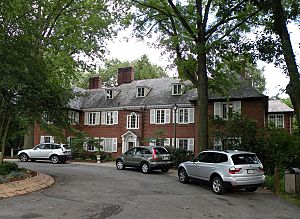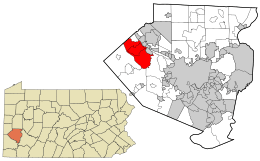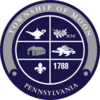Moon Township, Pennsylvania facts for kids
Quick facts for kids
Moon Township, Pennsylvania
|
|||
|---|---|---|---|
|
Township
|
|||

Robin Hill House in Moon Township
|
|||
|
|||

Location of Moon Township in Allegheny County and Pennsylvania
|
|||
| Country | United States | ||
| State | Pennsylvania | ||
| County | Allegheny | ||
| Incorporated | 1788 | ||
| Government | |||
| • Type | Council | ||
| Area | |||
| • Total | 24.12 sq mi (62.46 km2) | ||
| • Land | 23.83 sq mi (61.71 km2) | ||
| • Water | 0.29 sq mi (0.75 km2) | ||
| Elevation | 1,175 ft (358 m) | ||
| Population
(2020)
|
|||
| • Total | 27,261 |
||
| • Estimate
(2022)
|
26,782 | ||
| • Density | 1,073.57/sq mi (414.52/km2) | ||
| Time zone | UTC−5 (Eastern (EST)) | ||
| • Summer (DST) | UTC−4 (EDT) | ||
| ZIP Code |
15108
|
||
| Area code(s) | 412, 724 | ||
| FIPS code | 42-003-50784 | ||
| Website | Moon Township | ||
Moon Township is a community in Allegheny County, Pennsylvania, in the United States. It sits along the Ohio River. In 2020, about 27,261 people lived there. Moon Township is located about 12 miles (19 km) northwest of Pittsburgh. It is part of the larger Pittsburgh metropolitan area. The township is also home to a big airport, Pittsburgh International Airport.
Contents
History of Moon Township
Early Settlement (18th Century)
Moon Township was first settled by English traders and settlers in the early to mid-1700s. This happened as people moved westward into the Ohio Valley. During the French and Indian War, the Iroquois people, who used the land for hunting, gave up large parts of southwestern Pennsylvania. This happened through treaties or when they left the area.
Sometimes, settlers called "squatters" were already living on the land. Native American groups living on the south side of the Ohio River often moved to more populated areas. These areas were on the north side, near places like Sewickley and Ambridge today.
Settlers had arguments over who owned the land on the southern banks of the Ohio River. The Pennsylvania Land Office usually gave land to owners through official grants. However, some land in what is now Coraopolis Heights and the Thorn Run and Narrows Run valleys was claimed differently. This method was called "Tomahawk Improvements" and was often debated. Land settlement was confusing because different colonies, like Pennsylvania and Virginia, had different rules.
In 1769, Andrew Montour, an interpreter for the English during the French and Indian War, received one of the first land patents. This was for about 350 acres (1.4 km²) that later became Coraopolis and Neville Island. In 1773, a settler named John Meek got a 400-acre (1.6 km²) land grant from Virginia. This land was above the river bottom, between the Thorn Run and Montour Run valleys. This is when "Moon Township" began, though it wasn't officially recognized until 1788.
Other early grants were given to Robert Loudon and John Vail, totaling 600 acres (2.4 km²). Loudon's land was near the Meek grant. Vail's land was between the Thorn Run and Narrows Run valleys. Some historians believe other land speculators also claimed about 700 acres (2.8 km²). These areas were likely occupied by unknown squatters. When these squatters left, they gave up their claims to new settlers who would improve the land.
As the 1700s ended, new settlers moved to the area because the soil was good for farming. These pioneers were often wealthier than the first ones. They had the money to turn the hilly areas into farms.
Moon Township was officially created in 1788. It was one of the first townships in the new Allegheny County. In 1789, a part of Washington County south of the Ohio River was moved to Allegheny County. This area also became part of Moon Township.
At this time, Moon Township was huge, possibly 145 square miles (376 km²). Some stories say it would take a person on horseback two days to travel across the township. It was hard for settlers to do their civic duties, like voting or attending jury trials, because the area was so large. So, local governments began to divide the land into smaller communities. In 1790, Fayette Township was separated from Moon Township. Later, Findlay and Crescent townships were also formed.
19th Century Changes
In 1800, Beaver County was created from parts of Allegheny and Washington Counties. The part of Moon Township that Allegheny County lost to Beaver County was then divided. It became two new townships: First Moon and Second Moon Townships in Beaver County.
20th Century Growth
In 1943, the U.S. government built a housing area called Mooncrest. This was for workers who helped with defense during World War II. People living in Mooncrest made things like armor plates, ammunition, and ships for the war. After 1945, the U.S. Air Force operated the homes. In the mid-1950s, the homes were sold to private owners.
Moon Township became home to Pittsburgh International Airport in 1951. This airport replaced the Allegheny County Airport as the main one for the region. The area grew a lot because of the airport. Before this, the western hills of Allegheny County were mostly farms and small neighborhoods. On April 1, 1956, TWA Flight 400 crashed after taking off from the airport. Twenty-two people died just past the east end of the runway, which is in Moon Township.
New roads helped Moon Township become a major transportation hub. Pennsylvania Route 60 (now Interstate 376) was developed to the airport. Also, the Parkway West from Pittsburgh and nearby exits of Interstate 79 made it easy to get to Moon by car.
During the Cold War, Moon Township was the site of Nike Site PI-71. This was a place where the U.S. military kept Nike Ajax and/or Nike Hercules missiles. These missiles were used to defend against air attacks at high and medium altitudes. Today, the former missile site is a nature preserve.
In 1991, the main terminal of the Pittsburgh International Airport moved to nearby Findlay Township. This meant less traffic for Moon Township. Moon lost a lot of tax money, but it has since recovered. It is now a major cargo area for the airport. A large part of the airport's runways and facilities are still within Moon Township. However, the main terminal and about half of the airport's land are in Findlay Township.
Since the airport terminal moved, Moon Township has focused on other things. It has developed more corporate businesses, homes, and a university center. The main campus of Robert Morris University is also located in Moon Township.
In 2005, Moon Township supervisors created a new slogan: "Explore Our Universe." This slogan plays on the township's name. It also highlights Robert Morris University and the University Boulevard business area. Officials want people to explore these areas more.
Geography and Climate
Moon Township covers about 24.1 square miles (62.4 km²). Most of this area, about 23.7 square miles (61.4 km²), is land. About 0.3 square miles (0.78 km²), or 1.41%, is water.
| Climate data for Moon Township, PA (1991–2020 normals) | |||||||||||||
|---|---|---|---|---|---|---|---|---|---|---|---|---|---|
| Month | Jan | Feb | Mar | Apr | May | Jun | Jul | Aug | Sep | Oct | Nov | Dec | Year |
| Mean daily maximum °F (°C) | 35.6 (2.0) |
39.4 (4.1) |
48.5 (9.2) |
62.0 (16.7) |
71.8 (22.1) |
79.0 (26.1) |
83.0 (28.3) |
82.3 (27.9) |
75.6 (24.2) |
63.3 (17.4) |
50.8 (10.4) |
40.4 (4.7) |
61.0 (16.1) |
| Daily mean °F (°C) | 27.5 (−2.5) |
30.4 (−0.9) |
38.1 (3.4) |
49.8 (9.9) |
60.5 (15.8) |
68.6 (20.3) |
72.6 (22.6) |
71.3 (21.8) |
64.4 (18.0) |
52.2 (11.2) |
41.8 (5.4) |
33.1 (0.6) |
50.9 (10.5) |
| Mean daily minimum °F (°C) | 19.4 (−7.0) |
21.3 (−5.9) |
27.8 (−2.3) |
37.6 (3.1) |
49.2 (9.6) |
58.3 (14.6) |
62.2 (16.8) |
60.2 (15.7) |
53.2 (11.8) |
41.2 (5.1) |
32.7 (0.4) |
25.8 (−3.4) |
40.7 (4.8) |
| Average precipitation inches (mm) | 3.06 (78) |
2.59 (66) |
3.35 (85) |
3.56 (90) |
3.96 (101) |
4.37 (111) |
4.11 (104) |
3.56 (90) |
3.81 (97) |
3.07 (78) |
3.11 (79) |
3.25 (83) |
41.80 (1,062) |
| Source: NOAA | |||||||||||||
Neighboring Communities
Moon Township shares land borders with several other communities. These include Crescent Township to the north-northwest and Hopewell Township (in Beaver County) to the northwest. To the west and southwest is Findlay Township. North Fayette Township is to the south, and Robinson Township is to the southeast, east, and northeast. The borough of Coraopolis is to the north-northeast.
Across the Ohio River to the northwest, Moon Township is next to Edgeworth, Sewickley, and Glen Osborne. The Sewickley Bridge connects Moon Township directly to Sewickley.
Population and People
| Historical population | |||
|---|---|---|---|
| Census | Pop. | %± | |
| 1850 | 1,383 | — | |
| 1860 | 1,148 | −17.0% | |
| 1870 | 1,230 | 7.1% | |
| 1880 | 1,389 | 12.9% | |
| 1890 | 1,449 | 4.3% | |
| 1900 | 1,371 | −5.4% | |
| 1910 | 1,526 | 11.3% | |
| 1920 | 1,700 | 11.4% | |
| 1930 | 2,900 | 70.6% | |
| 1940 | 3,733 | 28.7% | |
| 1950 | 7,096 | 90.1% | |
| 1960 | 10,642 | 50.0% | |
| 1970 | 18,317 | 72.1% | |
| 1980 | 20,935 | 14.3% | |
| 1990 | 19,631 | −6.2% | |
| 2000 | 22,290 | 13.5% | |
| 2010 | 24,185 | 8.5% | |
| 2020 | 27,261 | 12.7% | |
| 2022 (est.) | 26,782 | 10.7% | |
| U.S. Decennial Census | |||
In 2000, Moon Township had 22,290 people living in 8,445 households. About 5,767 of these were families. The population density was about 939 people per square mile (362/km²). There were 9,200 housing units.
About 31.2% of households had children under 18. Most households (58.9%) were married couples. About 7.1% had a female head of household with no husband present. Around 26.8% of households were individuals living alone. About 6.7% had someone aged 65 or older living alone. The average household had 2.44 people, and the average family had 2.99 people.
The median age in the township was 38 years old. About 22.1% of the population was under 18. About 10.6% were between 18 and 24. Around 29.9% were between 25 and 44. About 24.6% were between 45 and 64. And 12.8% were 65 or older. For every 100 females, there were about 97.3 males.
The median income for a household in Moon Township was $57,173. For a family, it was $68,256. The income per person was $26,457. About 2.2% of families and 4.2% of the total population lived below the poverty line. This included 3.6% of those under 18 and 3.5% of those 65 or older.
Economy and Business
Moon Township is home to Pittsburgh International Airport, which is the main international airport for the Greater Pittsburgh area. The township also hosts military units. These include the Air Force Reserve Command 911th Airlift Wing, which started in 1943. The 171st Air Refueling Wing of the Pennsylvania Air National Guard is also here. The Army has its 99th Regional Readiness Command, built in the late 1990s.
Many major company headquarters are in Moon Township. These include Nova Chemicals, FedEx Ground, Dick's Sporting Goods, and First Health/Coventry. The National Weather Service forecast office for Pittsburgh is also located in Moon Township.
In late 2006, work began on the new Cherrington Parkway extension. This extension opened in early 2008. It created more ready-to-build land for office buildings and corporate development.
Robert Morris University plays a big role in the local economy. Many businesses along the township's University Boulevard area benefit from the college.
US Airways used to have its flight operations center in Moon Township. This was at Pittsburgh International Airport. It closed after US Airways merged with American Airlines in 2015.
Shopping and Retail
The West Hills Shopping Center used to be a main business area in Moon. In 2007, it was sold to Walmart for $4.7 million. Walmart announced plans to build a supercenter store there. The store opened in the fall of 2016.
On August 14, 2003, parts of Beers School and Narrows Run Roads were renamed University Boulevard. This change helped promote the township as the home of Robert Morris University. The new road name also showed the township's goal to become a strong business community again. Since 2003, officials have looked at different zoning rules to improve Moon's main business area.
Education in Moon Township
Moon Township is served by the Moon Area School District. This district includes students from both Moon and Crescent townships. The school district has about 3,900 students. They attend seven schools from kindergarten through 12th grade.
Robert Morris University is also in Moon Township. It has nearly 5,000 students. The university offers 60 bachelor's degree programs and 35 master's and doctoral programs.
Quality of Life
In 2007, Moon Township received several awards as one of the best places to live in the country. BusinessWeek.com ranked Moon as one of the five best affordable suburbs in the Northeast. This award included the 15108 zip code, which covers Coraopolis borough, Kennedy, and Moon townships.
In 2013, Moon was named a runner-up in the list of top Pittsburgh suburbs for raising a family.
Notable People from Moon Township
Many well-known people have connections to Moon Township:
- Kurt Angle, a famous wrestler who won an Olympic gold medal.
- Jodi Applegate, a former NBC News anchor.
- Jim Baechtold, a basketball player and coach.
- Barry Bonds, a baseball player who lived in Moon while playing for the Pittsburgh Pirates.
- Plaxico Burress, a football player who lived in Moon while playing for the Pittsburgh Steelers.
- John Calipari, a basketball coach.
- Lou Christie, a singer and songwriter.
- Willie Colon, a football player for the Pittsburgh Steelers.
- Bob Davie, a former Notre Dame football coach and ESPN sportscaster.
- Ann B. Davis, an actress.
- Joe DeNardo, a well-known meteorologist.
- Trai Essex, a football player for the Pittsburgh Steelers.
- Sean Gilbert, a football player for the Washington Redskins.
- James Harrison, a football player for the Pittsburgh Steelers.
- Cameron Johnson, a professional basketball player.
- Ryan Malone, a former hockey player for the Pittsburgh Penguins.
- Sarah Marince, a singer.
- Rich Milot, a former football player for the Washington Redskins.
- T. Mark Mustio, a Pennsylvania state representative.
- John Pippy, a former Pennsylvania state senator.
- Katelyn Pippy, an actress.
- Ray Seals, a football player who lived in Moon while playing for the Pittsburgh Steelers.
- A. Q. Shipley, a football player for the Arizona Cardinals.
- Brandon Wilson, an author and explorer.
- Khama Worthy, a former UFC fighter.
Moon Township in Media
Moon Township has been featured in movies and other media:
- Parts of the 1979 movie The Fish that Saved Pittsburgh were filmed in the gym at Moon Area High School.
- The production company Phalco Films started in Moon Township in 2006.
- Some scenes from the movie The Silence of the Lambs were filmed in Moon Township. Several Moon Township police officers appeared as extras.
- Parts of the movie Adventureland were filmed at the Stardust Lounge in Moon Township.
Presidential Visits
Because Pittsburgh International Airport is next to Moon Township, many presidents visit Moon when they come to Pittsburgh.
- President Gerald Ford made a surprise visit to Moon on September 9, 1974. This was the day after he pardoned President Richard M. Nixon.
- In 1994, President Bill Clinton met Prime Minister John Major of Great Britain. They met at a hangar at the 911th Air Wing of the Air Force Reserve in Moon Township.
- On March 16, 2000, then-Vice President Al Gore held a rally at Moon's high school gym. This was a day after he secured the Democratic nomination for president.
- In September 2009, President Obama visited Pittsburgh for the G-20 conference.
- Then-Republican presidential nominee Donald Trump held a rally at the Moon Township airplane hangar on June 11, 2016.
- On March 10, 2018, then-President Trump held another rally at the Moon Township airplane hangar. He was campaigning for Republican congressional candidate Rick Saccone in a special election.
See also
 In Spanish: Municipio de Moon para niños
In Spanish: Municipio de Moon para niños



